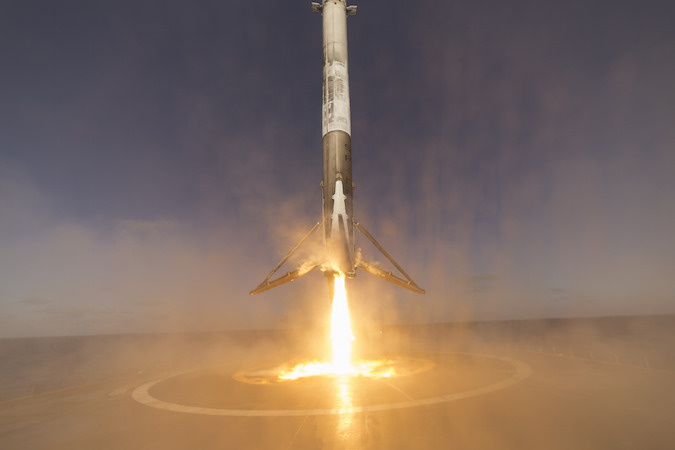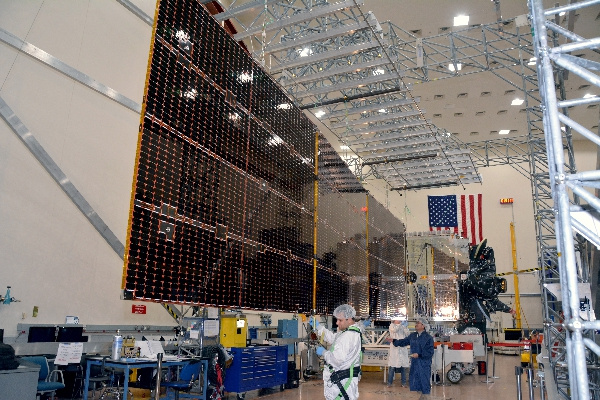5 May 2017, Stephen Clark (Stephen Clark)
 The first stage of the Falcon9 rocket descends onto a landing platform in the Pacific Ocean after launching on January 14 from the USAF Vandenberg, California © SpaceX
The first stage of the Falcon9 rocket descends onto a landing platform in the Pacific Ocean after launching on January 14 from the USAF Vandenberg, California © SpaceXA communications satellite manufactured in the USA and owned by Bulgaria will be launched in mid-June from the Kennedy cosmodrome in Florida. As the satellite owner reported on May 5, the satellite will be launched into orbit by the first stage of the Falcon9 rocket, which flew for the first time in January of this year.
The SES10 telecommunications satellite became the first payload that flew on a reusable commercial rocket on March 30, and now the first communication satellite of Bulgaria BulgariaSat-1 will be the second mission launched on one of the saved first steps of SpaceX.
In a statement, CEO BulgariaSat Maxim Zayakov said that reusable rockets were the technological breakthrough that would allow small countries and companies to launch their own satellites.
“Ilon Mask and his SpaceX team convinced me that people like them would bring us closer to a new quality of life by providing access to advanced technologies,” Zayakov said in a statement. “This is a chance for Bulgaria to join forces to develop these new opportunities for the space industry.”
In BulgariaSat said that the spacecraft will fly with the same first step Falcon9, which flew on January 14 from the US Air Force base, Vandenberg, California. Then the rocket put 10 satellites into orbit for the next generation of the Iridium communications satellite network.
After the second step reached the upper layers of the atmosphere, the first step of the Falcon9 returned down for a vertical landing on a platform in the Pacific Ocean south of Vandenberg, after which it was returned to the Port Los Angeles. SpaceX engineers inspected and updated the stage before a new round of pre-flight tests, to further send the stage to Cape Canaveral for launch in June.
BulgariaSat reserved a launch at SpaceX in 2014 as part of a satellite contract with Space Systems / Loral (
SSL ) from Palo Alto, California. SSL won a contract for BulgariaSat-1 with funding from the
Export-Import Bank of the United States , signing an agreement on the transfer of the satellite to its owner after launch. SSL negotiated a launch contract with SpaceX on behalf of BulgariaSat, a subsidiary of
Bulsatcom , Bulgaria’s largest digital television provider. Then it was expected that BulgariaSat-1 will be launched at the end of 2016.
 BulgariaSat-1 satellite during a recent verification of solar cell deployment at an SSL satellite factory in Palo Alto, California © BulgariaSat / SSL
BulgariaSat-1 satellite during a recent verification of solar cell deployment at an SSL satellite factory in Palo Alto, California © BulgariaSat / SSLIn BulgariaSat they do not disclose whether they received any discount for switching from the new Falcon9 rocket to the one already flying. It is believed that in exchange for launching consent at the already flown first stage, BulgariaSat-1 was recently moved forward in the Falcon9 flight queue, bypassing other customers.
BulgariaSat-1 will provide television and other communication services in the Balkans and for other regions of Europe. The satellite will have to be commissioned at the GSO about a month after launch.
“It took us almost 12 years to go from the concept, through financing and manufacturing, to the upcoming launch,” Zayakov said in a statement. “Starting on such a scale is an extraordinary test, not only in terms of technology and finance, but also for people.”
SpaceX founder Ilon Mask told reporters after the launch of SES10 on March 30 that his company intends to send up to six of the first Falcon9 first steps on this flight again.
Two of them will be used as side accelerators for the debut flight of the new SpaceX - Falcon Heavy rocket, awaiting launch in late summer, Musk said.
The three-body body Falcon Heavy is made of three first steps connected together Falcon9. The core will be a new product for the first, exclusively demonstration flight of a heavy Falcon Heavy. Musk said the test launch would be a “high risk” mission.
On March 30, Musk said, depending on the outcome of the SES10 mission, there is agreement from three or four other customers to remove cargo on partially used Falcon9 missiles.
“I think that quite a few companies are waiting to see (what will happen),” said an employee of one of the insurance companies that works in the satellite and launch market, before the launch of SES10. “A lot of this really has to do with the insurance market. If this happens successfully, then many customers will decide that it will be an argument that the community of insurance companies is not against the reuse of steps. ”
Officials did not disclose what discount SES received to be the first client for the flight at one of the SpaceX stages already in use.
Musk seeks to reduce the cost of launches in the long run, but at first price effects will be more modest. Gwynne Shotwell, President and COO SpaceX, said last year that the company would first offer a 10 percent discount to customers who want to entrust their cargo to missiles that have already flown.
“It will be a significant discount,” said Musk on March 30, without naming specific numbers. "We will come up with a way to recoup the development costs of reusability, so the price discount will not be equal to the cost savings, because we have to recoup the massive development cost."
"However, it will definitely be cheaper than the price of our current missiles, and will be much lower than any other rocket in the world," Musk added.
SpaceX says that the regular commercial launch of Falcon9 now costs about $ 62 million, already making it the cheapest choice in its weight class.
Musk said that SpaceX made the first stage of the Falcon9 rocket reusable using fully private funding, making investments of at least $ 1 billion, spending them to develop complex control algorithms, heat shields, jet propulsion capabilities and equipping mobile ocean platforms as landing sites.
The next two launches of SpaceX will use completely new Falcon9 rockets.
(Note. Translation - already running at the moment)Boeing's powerful communications satellite for London-based Inmarsat is scheduled to launch from the Kennedy cosmodrome starting May 15. The Inmarsat-5 F4 satellite, which will be launched at a GPO, will have a launch weight of about 6,100 kg, this will be the heaviest load for a GSO SpaceX has ever launched.
SpaceX said they would not attempt to rescue the first stage either on land or at sea after launching for Inmarsat, ensuring that the entire reserve of Falcon9 fuel would be spent on launching the satellite into orbit.
(Note. Translation - the launch was postponed from June 1 to 3, and it was already successful too)Another launch of Falcon9 is scheduled for June 1, and will send a Dragon cargo ship to deliver cargo to the ISS.
BulgariaSat-1 is next in line for SpaceX after the Dragon mission, followed by another launch of the next 10 satellites for Iridium from California and the launch of the Intelsat communications satellite from Florida in late June.